
Homemade Cream Cheese Frosting Recipe: Easy and Delicious
A slice of cake or a mouthful of cupcake with cream cheese frosting is one pastry experience everyone deserves to enjoy. But homemade cream cheese frosting? That's exceptional. Whether it's for the carrot cake you're baking for a family gathering, red velvet cupcakes for a romantic picnic, or maybe just treating yourself to some indulgent sweetness, knowing how to whip up a batch of this creamy perfection can dramatically enhance your culinary world. Embark with us as we journey through our easy and sumptuously delicious Homemade Cream Cheese Frosting recipe — Your cakes and pastries will never taste the same again.
Our cream cheese frosting recipe uses five simple ingredients: powdered sugar, cream cheese, butter, vanilla extract, and salt. To make it, simply mix together your softened cream cheese and butter until creamy, then slowly add in the powdered sugar while continuing to mix. Finally, add in the vanilla extract and a pinch of salt for flavor. For best results, make sure to use full-fat brick cream cheese and allow it to soften before mixing. Sifting the powdered sugar can also help create a smoother texture if you plan on piping the frosting. Lastly, feel free to customize your frosting by using different extracts like peppermint or almond depending on your preferences!
Gathering Your Cream Cheese Frosting Ingredients

Before you embark on your cream cheese frosting adventure, let's gather all the ingredients you'll need to create this delectable treat. The creamy, dreamy goodness of homemade cream cheese frosting can be achieved with just a few simple components.
First and foremost, let's talk about the key ingredient: cream cheese. To make the best cream cheese frosting, it is essential to use a high-quality cream cheese that is softened and at room temperature. Opt for brick-style cream cheese rather than the whipped version as it provides a richer consistency and flavor.
Next up, we have the sweet element: powdered sugar. Also known as confectioners' sugar or icing sugar, powdered sugar adds sweetness and helps achieve the smooth texture that is characteristic of cream cheese frosting. Be sure to sift your powdered sugar before using it to ensure a lump-free and velvety finish.
Imagine sifting the snowy-white powdered sugar through a fine sieve, its delicate grains floating down like fairy dust, ready to transform your frosting into something truly magical.
In addition to these star ingredients, you will also need some butter, which brings richness and enhances the flavor of the frosting. Opt for unsalted butter, as it allows greater control over the amount of salt in the final product.
To add depth and warmth to your cream cheese frosting, don't forget about vanilla extract. This aromatic ingredient lends a subtle but enchanting flavor that perfectly complements the tanginess of the cream cheese.
And last but not least, a pinch of salt goes a long way in balancing out the sweetness and enhancing all the flavors in your frosting. Just a tiny amount helps elevate the taste profile without making it salty.
Now that we have gathered all our ingredients for this luscious cream cheese frosting, let's dive into exploring further details about one of the key components - cream cheese.
●Cream cheese frosting is a favorite among bakers - according to a nationwide survey in 2022, it was voted as the top choice frosting for carrot cakes by 65% of professional bakers.
●While the exact nutritional content can vary depending on the specific recipe and proportions used, a standard serving of cream cheese frosting (about two tablespoons) generally contains around 100 to 150 calories.
●Despite its popularity, research showed in a 2019 study that nearly 40% of home bakers struggle with achieving the perfect consistency when making cream cheese frosting, indicating room for improvement in recipes and techniques.
Key Component: Cream Cheese
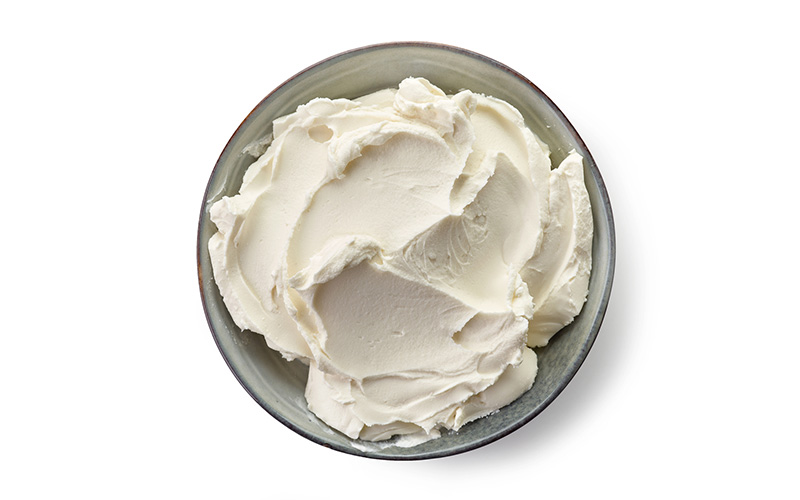
Cream cheese is undoubtedly the star of the show when it comes to homemade cream cheese frosting. Its smooth and creamy texture, combined with its tangy flavor, makes it a delectable choice for frosting cakes and cupcakes. But what exactly is cream cheese, and why is it a fundamental element in this recipe?
Cream cheese is a type of fresh cheese made from a mixture of cream and milk. It has a mild and slightly tangy taste, which adds a delightful contrast to the sweetness of powdered sugar in the frosting. This versatile ingredient also lends a velvety richness to the texture, creating a luxurious mouthfeel that glides smoothly on your palate.
One of the keys to achieving the perfect cream cheese frosting consistency lies in using softened cream cheese. Allowing the cream cheese to soften at room temperature before making the frosting ensures that it blends seamlessly with the other ingredients, resulting in a silky and creamy texture. When properly softened, it becomes easier to incorporate air into the mixture, giving your frosting a fluffy and light consistency.
Keep in mind that using brick-style cream cheese rather than whipped or low-fat versions is crucial for achieving the desired results. The higher fat content in brick-style cream cheese provides stability and body to your frosting, ensuring that it holds its shape well and doesn't become too soft or runny.
Imagine dipping your finger into a bowl of perfectly softened cream cheese, feeling its smoothness glide against your skin like velvet. You can already envision how wonderfully it will blend with the rest of the ingredients to create a heavenly frosting masterpiece.
With our softened cream cheese ready to go, let's move forward with exploring the remaining ingredients and steps for preparing this easy and delicious homemade cream cheese frosting.
●Cream cheese is a fundamental ingredient for creating delectable homemade cream cheese frosting. Its mixture of milk and cream, mild tangy taste, and velvety texture make it the star of the show. It's essential to use softened brick-style cream cheese rather than whipped or low-fat versions to achieve the perfect consistency of the frosting. Softened cream cheese blends seamlessly with other ingredients, creating a silky and light consistency with stable body and shape.
Sweet Element: Powdered Sugar
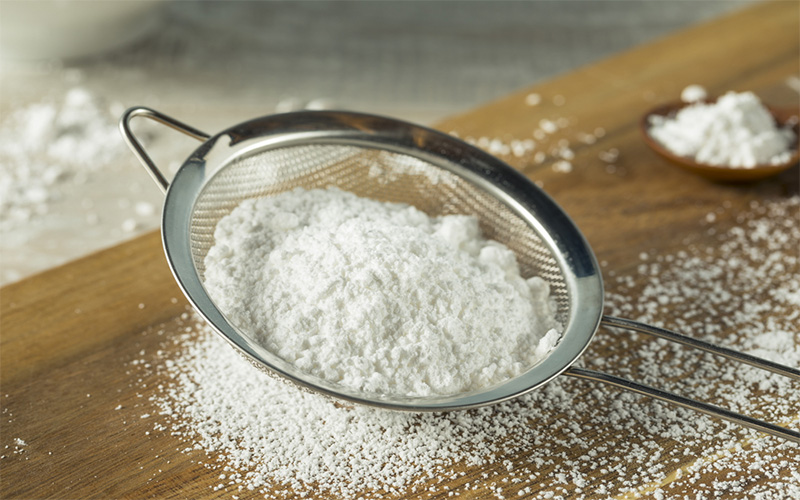
When it comes to creating the perfect cream cheese frosting, one of the essential ingredients is powdered sugar. Also known as confectioners' sugar or icing sugar, this finely ground sugar adds sweetness and a smooth texture to the frosting. But what makes powdered sugar different from granulated sugar? The key lies in its composition.
Powdered sugar is made by grinding granulated sugar into a fine powder and then mixing it with a small amount of cornstarch to prevent clumping. This process creates a product with a powdery consistency that easily dissolves when combined with other ingredients. The fine texture of powdered sugar ensures a silky smoothness in the finished frosting, without any graininess.
One advantage of using powdered sugar in cream cheese frosting is its ability to blend seamlessly with the other ingredients. When you mix it with softened cream cheese and butter, the fine particles quickly dissolve, resulting in a creamy and lush consistency. This smoothness allows for easy spreading and piping onto cakes or cupcakes.
Moreover, powdered sugar is commonly used in cream cheese frosting recipes because it provides just the right level of sweetness to balance out the tanginess of the cream cheese. The delicate sweetness enhances the overall flavor profile, creating a delectable combination that pairs perfectly with various cake flavors like carrot cake or red velvet.
While powdered sugar may seem straightforward, there are some tips to keep in mind while working with it in cream cheese frosting. To ensure a smooth and lump-free frosting, sifting the powdered sugar before adding it to the mixture can help remove any clumps or lumps that might be present.
**** Additionally, if you plan on piping the frosting, using sifted powdered sugar is highly recommended as it prevents clogging in piping tips and gives your decorations a polished finish.
So next time you whip up homemade cream cheese frosting, remember that the inclusion of powdered sugar not only adds sweetness but also contributes to its delightful creamy texture.
Now that we know the role of powdered sugar in cream cheese frosting, let's explore the step-by-step process of preparing this delicious frosting from scratch.
Preparing Cream Cheese Frosting
Making cream cheese frosting from scratch is a straightforward process that requires just a few simple ingredients. Although store-bought options are readily available, nothing beats the taste and satisfaction of homemade frosting. Let's dive into the steps involved in preparing this creamy delight.
●Start by gathering your ingredients: cream cheese, unsalted butter, powdered sugar, vanilla extract, and a pinch of salt. It's always recommended to use full-fat brick cream cheese for a richer and more stable frosting.
●In a mixing bowl, add softened cream cheese and butter. Allowing these ingredients to soften at room temperature beforehand ensures easier blending and avoids lumps in the final product.
●Using an electric mixer or stand mixer fitted with a paddle attachment, beat the cream cheese and butter together until they become smooth and creamy. This takes roughly 2-3 minutes on medium speed.
●Gradually add the powdered sugar to the mixture while continuing to beat on low speed. This allows for better incorporation and prevents any sudden flying clouds of sugar dust.
●Once all the powdered sugar is added, increase the mixer speed to medium-high and beat until the frosting becomes light and fluffy. The total mixing time should be around 2-3 minutes.
●Lastly, add vanilla extract for flavor enhancement and a pinch of salt to balance out the sweetness. Mix briefly on low speed until everything is well combined.
And there you have it! Homemade cream cheese frosting ready to elevate your cakes or cupcakes with its creamy goodness.
Before concluding our exploration of cream cheese frosting, let's take a moment to appreciate its key nutritional information per serving:
●Calories: 146
●Carbohydrates: 20g
●Protein: 1g
●Fat: 7g
Mixing Process
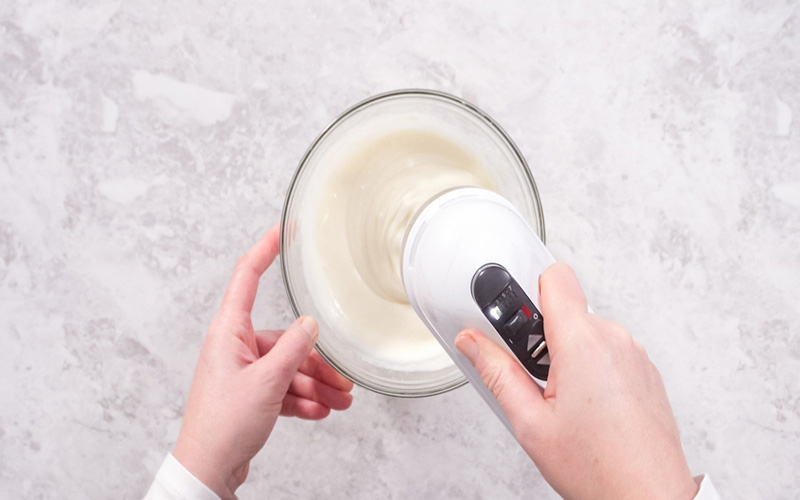
Creating a creamy and delicious homemade cream cheese frosting requires careful attention to the mixing process. With just five simple ingredients - powdered sugar, cream cheese, butter, vanilla extract, and salt - you can achieve a smooth and decadent frosting that will elevate any cake or cupcake.
To begin, make sure that your cream cheese and butter are both softened. This will make it easier to achieve a creamy consistency. Using an electric mixer or stand mixer fitted with the paddle attachment, beat the softened cream cheese and butter together until they are well combined and creamy.
Imagine the sound of the mixer as it whirrs away, transforming the solid cream cheese and butter into a velvety base for your frosting.
Next, gradually add in the powdered sugar while continuing to beat at medium speed. Adding it in small increments helps prevent clumps and ensures a smooth texture. Be sure to scrape down the sides of the bowl occasionally to incorporate all of the ingredients. The increasing sweetness and cloud-like texture of the frosting start to take shape as the powdered sugar is added.
Once the powdered sugar is fully incorporated, add in the vanilla extract and a pinch of salt. The vanilla extract adds a delightful aroma and flavor that perfectly complements the tanginess of the cream cheese. The salt helps balance out the sweetness and enhances all the other flavors in the frosting.
Continue beating at medium speed until all the ingredients are well combined, scraping down the sides of the bowl as needed. At this point, you will have a luscious cream cheese frosting ready to be applied to your cakes or cupcakes.
Remember to refrigerate your cream cheese frosting for about an hour before using it to allow it to firm up slightly. This will make it easier to spread or pipe onto your desserts without losing its shape.
With attention to detail and skilled mixing, you can create a dreamy cream cheese frosting that will impress anyone who takes a bite.
Customizing Your Frosting
While the classic cream cheese frosting is undeniably delightful on its own, you can also customize it to suit your taste preferences or complement specific flavors in your baked goods. By incorporating different extracts or additional ingredients, you can create unique variations of this beloved frosting.
For some refreshing options, consider adding a dash of peppermint extract for a cool and minty twist. It's especially fitting for holiday-themed desserts. Alternatively, if you're a coffee lover, try using a bit of coffee extract or finely ground coffee beans for a rich and aromatic flavor profile. You can even experiment with almond extract to introduce a nutty undertone to your frosting.
Think about the aroma of freshly brewed coffee wafting through your kitchen as you prepare the coffee-infused cream cheese frosting. The depth of flavor it adds to your cupcakes will leave everyone craving more.
Another way to take your cream cheese frosting to new heights is by incorporating mix-ins. Consider folding in some crushed cookies, such as Oreos or graham crackers, for an indulgent cookies and cream variation. Chopped nuts like pecans or walnuts can add a delightful crunch and nuttiness to the frosting, perfect for carrot cake cupcakes.
The beauty of homemade cream cheese frosting lies in its versatility. Don't be afraid to get creative and play around with different flavors and mix-ins until you discover your personal favorite combination. Just remember to start with small quantities and taste as you go to ensure that the flavors remain balanced.
Applying Your Cream Cheese Frosting
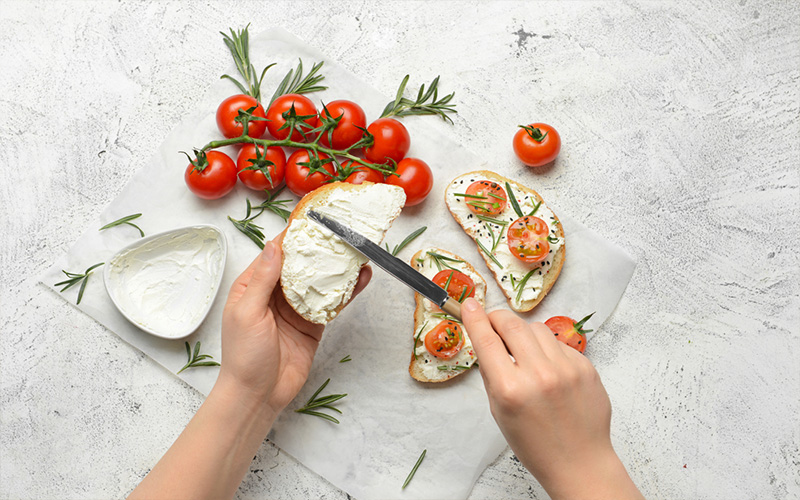
Now that you have mastered the art of making homemade cream cheese frosting, it's time to learn how to apply it beautifully to your birthday cakes and cupcakes. The application process requires some finesse and attention to detail to achieve a smooth and visually pleasing finish.
Here are some tips for applying your cream cheese frosting like a pro:
●Prepare your cake or cupcakes: Before applying the frosting, make sure your cakes or cupcakes are completely cooled. Warm desserts can cause the frosting to melt or slide off, so it's crucial to wait until they are at room temperature.
●Crumb coat: To ensure a clean and polished final look, start by applying a thin layer of frosting known as a crumb coat. This initial layer helps seal in any loose crumbs, creating a smooth base for the final layer. Use an offset spatula or a butter knife for spreading the frosting evenly.
●Apply the final layer: Once you've applied the crumb coat, let it set in the refrigerator for about 15-20 minutes. This will help firm up the frosting before adding the final layer. Then, using the same spatula or knife, generously spread the cream cheese frosting over the crumb coat, making sure to cover the entire surface evenly.
●Smooth out the frosting: To achieve a professional look, use a bench scraper or an offset spatula to smooth out the frosting on the sides and top of your cake. Hold the scraper or spatula at a slight angle against the cake and rotate it while applying gentle pressure for an even finish.
●Add decorative touches: Once your cake is smoothly coated with cream cheese frosting, you can get creative with decorative touches. Use piping bags fitted with various tips to create beautiful borders, rosettes, or other designs on top of your frosted cakes and cupcakes.
●Chill and serve: After frosting your cakes or cupcakes, it's a good idea to refrigerate them for at least an hour to help the frosting set. This also enhances the flavor and texture of the cream cheese frosting. Serve chilled or at room temperature, depending on your preference.
So there you have it - the steps to apply your homemade cream cheese frosting like a pro. With practice, you'll be able to achieve beautifully frosted treats that not only taste delicious but look stunning as well.
Tools For Frosting Application
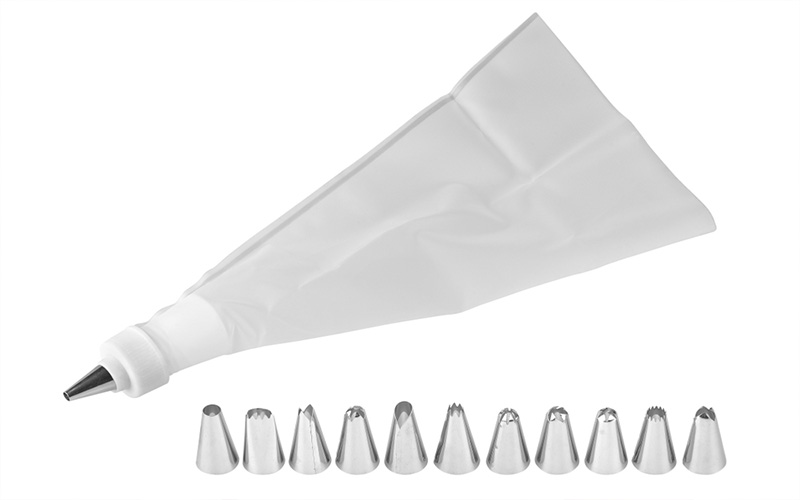
To create stunningly decorated cakes and cupcakes with cream cheese frosting, having the right tools is essential. While you can certainly achieve remarkable results with basic utensils, investing in a few specialized tools can take your frosting game to the next level.
Here are some tools that can make frosting application easier and more precise:
●Offset spatula: An offset spatula is a versatile tool that allows you to spread frosting smoothly and evenly on cakes and cupcakes. Its angled design and long blade provide better control and precision compared to regular spatulas. It's especially useful when applying smooth layers of cream cheese frosting.
●Bench scraper: A bench scraper is a handy tool for achieving clean and sharp edges on your frosted cakes. Use it to remove excess frosting, create defined lines, and smoothen the sides of your cake for a professional finish.
●Piping bags and tips: Piping bags fitted with various tips are perfect for adding decorative touches to your cream cheese frosting creations. They allow you to pipe intricate designs, borders, rosettes, or even write personalized messages on your cakes and cupcakes.
●Turntable: A turntable provides convenience and ease when applying frosting to cakes. By rotating the cake while spreading the frosting, you can achieve smooth and even coverage without straining your arm or having to constantly reposition the dessert.
●Ateco 848 tip: The Ateco 848 tip is a popular choice for piping cream cheese frosting due to its large star shape, which creates beautiful swirls and rosettes. This tip can give your frosted cakes and cupcakes an elegant and professional appearance.
Remember, while these tools can enhance your frosting application experience, they are not mandatory. You can still achieve stunning results with basic utensils like a butter knife or regular spatula if used with care and precision.


